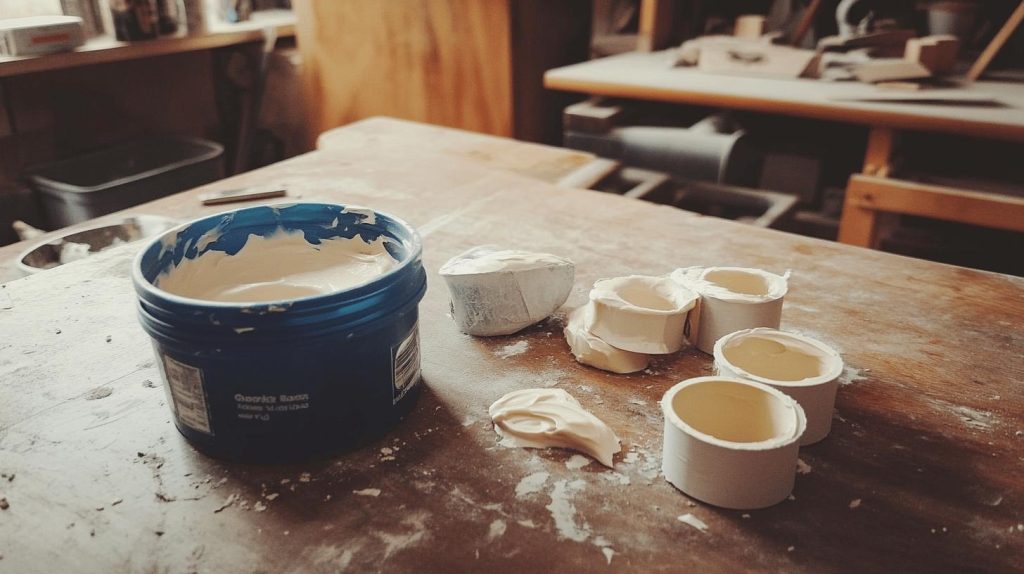A drip beneath your sink is an annoying sight, and for many people, the first thought is to find a quick, affordable fix without calling a professional. It’s at this moment you might come across plumber’s putty, a popular, clay-like compound often touted as a DIY saviour. But what is plumber’s putty, really? And when should you use it, or more importantly, when should you trust the job to a professional?
This guide will explain exactly what plumber’s putty is and when it’s an appropriate solution. It will also clarify why, for most plumbing repairs, a professional’s expertise is the only way to ensure a lasting, leak-free result.
What is Plumber’s Putty?
At its core, plumber’s putty is a soft, pliable sealing compound. Think of it as a flexible filler that does not dry hard like cement, nor does it stay sticky like glue. Instead, it remains slightly malleable, which makes it ideal for creating watertight seals in areas with minimal movement or low pressure.
A common mistake is confusing it with silicone sealant. Both can stop leaks, but they aren’t the same. Silicone cures to a rubbery finish and adheres firmly to surfaces, making it ideal for areas exposed to constant water or where flexibility is essential. Plumber’s putty, on the other hand, is easier to remove and reposition, making it one of the main reasons plumbers use it for fittings that may need to be disassembled later.
So, what does plumbers’ putty do?
In simple terms, it fills gaps to prevent water from sneaking through joints. Most commonly, you will see it used around sink drains, faucets, and similar fixtures. It is not designed for sealing high-pressure pipes, but for the right jobs, it is incredibly handy.
Key Uses of Plumber’s Putty
So where does this clay-like material really shine? Here are the most common plumbers’ putty uses:
Sealing Sink Drains
Probably the number one use. When installing or replacing a sink drain, plumbers’ putty seals the metal flange to the sink, ensuring water doesn’t seep into the cabinet below.
Around Faucets
When mounting faucets, small gaps often form between the faucet base and the sink surface. Putty fills those gaps, preventing water from dripping underneath.
Strainers and Baskets
If your kitchen sink has a strainer basket, plumbers’ putty is usually rolled out and applied underneath the lip before tightening everything down.
Toilet Installations
This is where things get a little tricky. Many DIYers ask about toilet putty. Traditionally, it can be used around certain toilet bases or to seal toilet bowls to the floor. But plumbers often prefer wax rings or specialised sealants for the main toilet drain. Putty may still be helpful for smaller fittings around toilets, but it’s not always the first choice.
One of the biggest advantages of plumber’s putty is its removability. If you ever need to take the fixture apart, you won’t have to chisel away hardened sealant; it simply pulls away. That flexibility is why plumbers keep it in their toolkits.
How Professionals Use Plumber's Putty
Plumber’s putty is a staple in a professional’s toolkit, not a simple DIY fix. Knowing how to use plumbers’ putty to stop a leak effectively requires a clear understanding of its purpose and limitations. It’s a precise application that, if done incorrectly, can lead to costly water damage.
Here’s how a professional would approach using plumber’s putty during an installation:
- Proper Diagnosis: First, a professional confirms that plumber’s putty is the correct sealant for the job, as it’s not suitable for all materials or pressurised pipes. Using the wrong product can cause more damage than the original leak.
- Surface Perfection: The surface is meticulously cleaned and dried. Any dirt, grease, or old sealant is removed entirely, as even the smallest contaminant can compromise the seal.
- Precise Application: The compound is rolled into a uniform, rope-like shape and applied evenly. Too little and the seal will fail; too much and it will squeeze out, leaving no seal at all.
- Measured Tightening: The fixture is tightened with just the right amount of pressure. This step is critical; overtightening will push all the putty out, while undertightening will not create a watertight seal. This balance is something only a professional can master through experience.
- Final Inspection: The job isn’t done until the excess is carefully removed and the entire installation is checked for leaks under real-world conditions. A professional will also provide a guarantee on their work, giving you peace of mind.
While the steps might look straightforward, a professional understands the nuances that make all the difference.
Common Mistakes to Avoid
Even though plumber’s putty is beginner-friendly, it does have limits. Here are some pitfalls to watch out for:
- Using it on plastic or porous materials: Some putties don’t bond well to these surfaces and may even stain them.
- Applying it in high-pressure areas: It’s not meant for sealing pipes carrying water under pressure.
- Treating it like glue: Remember, it seals gaps by filling space; it’s not an adhesive.
Plumber’s Putty vs Silicone Sealant
This is probably the most common point of confusion. Silicone is flexible, strong, and creates a lasting waterproof bond. Plumber’s putty is softer, easier to shape, and removable.
So when should you choose one over the other?
- Use plumber’s putty for fixtures you may want to remove or adjust later, like sink drains or faucet bases.
- Use silicone for permanent, watertight seals in areas exposed to standing water, such as shower corners or around bathtubs.
In reality, both belong in a DIY toolkit. The trick is knowing when each makes sense.
FAQs
Can I use plumber’s putty to stop a leak permanently?
Not really. It’s best for preventing leaks during installation, not fixing ongoing ones. For major leaks, you’ll need a permanent solution or professional help.
Is plumber’s putty safe for toilets?
Yes, but only for certain fittings. For sealing the toilet base to the drain, wax rings or modern seals work better. Use toilet putty, which works best on smaller, non-drain parts of the installation.
How long does plumber’s putty last?
Applying it correctly can keep it working for years. Since it does not harden, it stays effective unless disturbed or exposed to harsh conditions.
Does plumber’s putty harden over time?
No, it stays soft and pliable. That’s one of its advantages, as you can disassemble fixtures without scraping off hardened sealant.
Can I use plumber’s putty on PVC pipes?
Generally no. It’s not designed for plastic pipes. For PVC, use PVC cement or a silicone-based sealant instead.
Conclusion
Plumber’s putty may not be glamorous, but it earns its place in every DIY plumbing toolkit. It is reliable, simple to use, and most importantly, removable. From sealing sink drains to preventing water from sneaking under faucets, its value lies in handling small but critical jobs.
Plumber’s putty has its limitations. It cannot replace specialised materials in high-pressure systems and may not be suitable for modern toilets or certain plastics. Still, for routine sink or faucet installations, it’s a lifesaver.
If your plumbing problem goes beyond a simple seal, our team is here to help.
At Perspective Plumbing, we know not every leak can be solved with a quick DIY fix. If you’re dealing with stubborn drips, blocked drains, or a plumbing emergency, our licensed team is ready to step in. Whether you’re looking for a reliable plumber in Craigieburn or Epping, we’ve got you covered.
Call Perspective Plumbing today at 0411 295 646 and let us get your home back to normal quickly.




